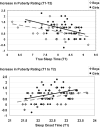Sleep and the transition to adolescence: a longitudinal study
- PMID: 20041596
- PMCID: PMC2786044
- DOI: 10.1093/sleep/32.12.1602
Sleep and the transition to adolescence: a longitudinal study
Abstract
Study objectives: To assess the links between sleep and pubertal development using a longitudinal design.
Design: Three consecutive annual assessments of sleep and pubertal development. Sleep was assessed using a week of home actigraphy.
Setting: Naturalistic sleep in the home setting of school children, Tel Aviv Area, Israel.
Participants: A sample of 94 (41 boys) typically developing healthy school-age children (age range at first assessment: 9.9-11.2 years).
Intervention: N/A.
Measurements and results: The Petersen's Pubertal Development Scale (PDS) and Sexual Maturation Scale (SMS) were used to assess pubertal development, and a week of actigraphy served to assess naturalistic sleep patterns. The results reflect expected developmental trends: an increase in signs of pubertal maturation, delayed sleep onset, and shorter sleep time. After controlling for age, significant relationships were found between sleep onset time, true sleep time, and number of night wakings at Time 1 and pubertal ratings at Time 2, and pubertal changes from Time 1 to Time 2. Delayed and disrupted sleep at Time 1 predicted faster pubertal changes from Time 1 to Time 2. These results were supported by structural equation modeling. These findings were similar in boys and girls.
Conclusions: Based on these longitudinal data, it appears that pubertal changes in sleep (delayed sleep phase and disrupted sleep patterns) antedate bodily changes associated with puberty. The underlying mechanisms explaining these predictive links should be further explored.
Figures




Similar articles
-
Parental time to pregnancy, medically assisted reproduction and pubertal development in boys and girls.Hum Reprod. 2019 Apr 1;34(4):724-732. doi: 10.1093/humrep/dez008. Hum Reprod. 2019. PMID: 30753468 Free PMC article.
-
Continuity and change in poor sleep from childhood to early adolescence.Sleep. 2014 Feb 1;37(2):289-97. doi: 10.5665/sleep.3400. Sleep. 2014. PMID: 24497657 Free PMC article.
-
The onset of pubertal development and actigraphy-assessed sleep during middle childhood: Racial, gender, and genetic effects.Sleep Health. 2022 Apr;8(2):208-215. doi: 10.1016/j.sleh.2021.12.006. Epub 2022 Feb 21. Sleep Health. 2022. PMID: 35210201 Free PMC article.
-
Association between Sleep Duration and Early Pubertal Timing in Children and Adolescents: A Systematic Review and Meta-analysis.Curr Pediatr Rev. 2023;19(3):318-328. doi: 10.2174/1573396318666220819145346. Curr Pediatr Rev. 2023. PMID: 35986543
-
Fetal nutrition and timing of puberty.Endocr Dev. 2005;8:15-33. doi: 10.1159/000084084. Endocr Dev. 2005. PMID: 15722615 Review.
Cited by
-
Estimating the dim light melatonin onset of adolescents within a 6-h sampling window: the impact of sampling rate and threshold method.Sleep Med. 2016 Apr;20:59-66. doi: 10.1016/j.sleep.2015.11.019. Epub 2015 Dec 18. Sleep Med. 2016. PMID: 27318227 Free PMC article.
-
Linear and Nonlinear Associations between Sleep and Adjustment in Adolescence.Behav Sleep Med. 2020 Sep-Oct;18(5):690-704. doi: 10.1080/15402002.2019.1665049. Epub 2019 Sep 19. Behav Sleep Med. 2020. PMID: 31537121 Free PMC article.
-
Family accommodation mediates nightmares and sleep-related problems in anxious children.J Anxiety Disord. 2019 Mar;62:94-99. doi: 10.1016/j.janxdis.2019.01.004. Epub 2019 Jan 14. J Anxiety Disord. 2019. PMID: 30660831 Free PMC article.
-
Sleep to Internalizing Pathway in Young Adolescents (SIPYA): A proposed neurodevelopmental model.Neurosci Biobehav Rev. 2022 Sep;140:104780. doi: 10.1016/j.neubiorev.2022.104780. Epub 2022 Jul 14. Neurosci Biobehav Rev. 2022. PMID: 35843345 Free PMC article. Review.
-
Managing Circadian Rhythms: A Key to Enhancing Mental Health in College Students.Psychiatry Investig. 2024 Dec;21(12):1309-1317. doi: 10.30773/pi.2024.0250. Epub 2024 Dec 23. Psychiatry Investig. 2024. PMID: 39757810 Free PMC article.
References
-
- Dahl RE, Lewin DS. Pathways to adolescent health: Sleep regulation and behavior. J Adolesc Health. 2002;31:175–84. - PubMed
-
- Carskadon MA, Acebo C. Regulation of sleepiness in adolescents: Update, insights, and speculation. Sleep. 2002;25:606–14. - PubMed
-
- Carskadon MA, Acebo C, Jenni OG. Regulation of adolescent sleep: implications for behavior. Ann N Y Acad Sci. 2004;1021:276–91. - PubMed
-
- Carskadon MA, Vieira C, Acebo C. Association between puberty and delayed phase preference. Sleep. 1993;16:258–62. - PubMed
-
- Wolfson AR, Carskadon MA. Understanding adolescents' sleep patterns and school performance: a critical appraisal. Sleep Med Rev. 2003;7:491–506. - PubMed
Publication types
MeSH terms
LinkOut - more resources
Full Text Sources
Medical
Miscellaneous

